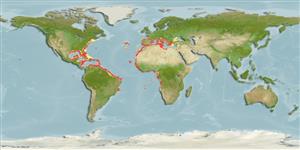Malacostraca |
Decapoda |
Penaeidae
Environment: milieu / climate zone / djupintervall / distribution range
Ekologi
Bentopelagisk; djupintervall 20 - 828 m (Ref. 8), usually 100 - 400 m (Ref. 8). Subtropical; 8°C - 15°C (Ref. 804), preferred 24°C (Ref. 107945); 48°N - 19°S, 98°W - 37°E
Atlantic and the Mediterranean: from USA to French Guiana, the entire Mediterranean and from Portugal to Namibia.
Length at first maturity / Size / Weight / Age
Könsmognad: Lm 2.4, range 1 - 2.8 cm Max length : 16.0 cm TL hane/ej könsbestämd; (Ref. 8); 19 cm TL (female); common length : 14.0 cm TL hane/ej könsbestämd; (Ref. 8); common length :16 cm TL (female); rapporterad maxålder: 3.00 år (Ref. 80253)
Demersal (Ref. 85316). Maximum depth range from Ref. 114857; minimum common depth from Ref. 80253. Maximum total length (female) from Ref. 104052 Prefers mud or muddy sand substrates (Ref. 8). Juveniles settle at around 100 m, though can be detected up to 300 m, while larger individuals are always found deeper than 350 m (Ref. 80253). Feeds on benthic organisms (clams, mysids and small crangonids; Ref. 434). Also occurs in pelagic depths between 100 to 200 m (Ref. 92299). Opportunistic predator (Ref. 112170).
The species has a life cycle of 2 to 3 years (Ref. 80253). Mating behavior: Precopulatory courtship ritual is common (through olfactory and tactile cues); usually indirect sperm transfer (Ref. 833).
Holthuis, L.B. 1980 FAO Species Catalogue. Vol. 1. Shrimps and prawns of the world. An annotated catalogue of species of interest to fisheries. FAO Fish. Synop. 125(1):271 p. Rome: FAO. (Ref. 8)
IUCN Red List Status
(Ref. 130435: Version 2025-1)
CITES status (Ref. 108899)
Not Evaluated
Not Evaluated
Threat to humans
Human uses
Fiskeri: kommersiell
FAO - fiskeri: landings, species profile | FIRMS (Stock assessments) | FishSource | Sea Around Us
Verktyg
Ytterligare information
PhysiologySyreförbrukning
Human RelatedStamps, coins, misc.
Internet-källor
Estimates based on models
Preferred temperature
(Ref.
115969): 9.4 - 19.5, mean 14 (based on 393 cells).
Resiliens
Hög, lägsta populationsfördubblingstid mindre än 15 månader (K=0.44-2; tm=0.6; tmax=3).
Prior r = 1.40, 95% CL = 0.92 - 2.10, Based on 15 full stock assessments.
Fishing Vulnerability
Low vulnerability (15 of 100).
Climate Vulnerability
Low to moderate vulnerability (32 of 100).
Nutrients : Calcium = 109 [35, 184] mg/100g; Iron = 1.59 [1.21, 1.97] mg/100g; Protein = 20.2 [19.2, 21.3] %; Omega3 = 0.285 [0.185, 0.386] g/100g; Selenium = 48.3 [-31.7, 128.3] μg/100g; VitaminA = 0 μg/100g; Zinc = 1.79 [1.17, 2.40] mg/100g (wet weight); based on
nutrient studies.
